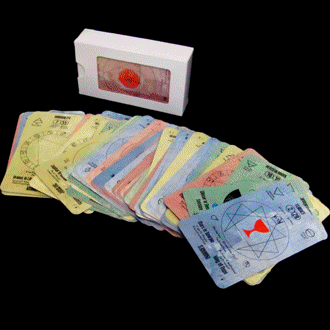Yearly Archives: 2019
Cartomancy, Class One PDF


Cartomancy, Class one is an A5 size, 24 pages PDF document written and edited by Attila Blága. The document is not editable, but printable.
The booklet consists of six chapters: Read more Cartomancy, Class One PDF
Archetypes and iconography


“…the Alphabet of Thoth can be dimly traced in the modern Tarot which can be had at almost every bookseller in Paris. As for it being understood or utilised, the many fortune-tellers in Paris, who make a professional living by it, are sad specimens of failures of attempts at reading, let alone correctly interpreting the symbolism of the Tarot without a preliminary philosophical study of the Science.” – Helena Petrovna Blavatsky Read more Archetypes and iconography
A brief history of cards and fortune-telling


History is the study of the past as it is described in written documents and based on physical evidence.
The earliest official mention of playing cards was made in 868 and came from the Chinese writer Su E who describes Princess Tong Cheng playing the “leaf game” with the royal family.
Supposedly, from China, the cards spread to India, Persia and eventually Egypt. Read more A brief history of cards and fortune-telling
The esoteric diet


Staying or getting fit, living a healthy life is one of the Holy Grail of modern man. All sort of ‘miraculous’ or ‘secret’ methods are circulated nowadays. However, not so many people are aware that esotericism deals not only with abstract and apparently fruitless theoretical aspects but also with the health of the physical body.
According to the most commonly used definition in the dictionaries, esoteric means “intended for or likely to be understood by only a small number of people with specialised knowledge or interest.”
People are generally scared and refractive of things they do not know or do not understand. Bringing up ‘esotericism’ is one of those things that makes people uncomfortable. Esoteric is often considered mysticism and the sum of dubious medieval superstitions and practices. Read more The esoteric diet
Reading with the Magic Tarot by Frederic Lionel


Frédéric Lionel was born on 17 July 1908, in Amphion les Bains, France. “The Magic Tarot: Vehicle of Eternal Wisdom” was published initially in Franch by Editions du Rocher in 1980. The English translation I own was published in 1982 by Routledge & Kegan Paul Ltd. The book was accompanied by an exclusive, Major Arcana only deck designed by Lionel. The Magic Tarot is one of the very few specially designed, esoteric – divinatory if you prefer – Tarot decks. While the traditional Western esoteric system, primarily represented by the Golden Dawn, is Kabbalah based and only by subordination connected to Astrology and Numerology, Lionel’s work focuses on Alchemy and aspects of self-development and enlightenment. Read more Reading with the Magic Tarot by Frederic Lionel
Two plus two make four

‘Do you remember,’ he went on, ‘writing in your diary, ‘Freedom is the freedom to say that two plus two make four’?’ Read more Two plus two make four
Aquarian Hermetic Tarot (2019)


Hermeticism, also called Hermetism, is a philosophical and esoteric tradition based primarily upon the writings attributed to Hermes Trismegistus. The name Hermes Trismegistus in Ancient Greek means ‘thrice-greatest Hermes’ and was translated into Latin as “Mercurius ter Maximus”.
Hermes Trismegistus may be associated with the Greek god Hermes and the Egyptian god Thoth.
Read more Aquarian Hermetic Tarot (2019)
Archetypes and genders within the Major Arcana cards


The things we have been taught, the way we have been educated and cultivated, shaped the way we think. These patterns are the measure of our artificial limitations. What concerns me is that we accept and learn – memorise – anything without questioning and thinking. “Believe and do not question” applies not exclusively to the church dogmas but also to rational and scientific matters. Esotericism, although dealing with the invisible aspects of our universe – the macrocosm – and ourselves – the microcosm –, it is science. Read more Archetypes and genders within the Major Arcana cards
The Hermit in Botticelli’s Temptations of Christ


The Temptations of Christ is a fresco by the Italian Renaissance painter Sandro Botticelli, executed in 1480–1482 and located in the Sistine Chapel, Rome.
In 1480 Botticelli, together with a couple other Florentine painters, left for Rome, where he had been called as part of the reconciliation project between Lorenzo de’ Medici, the de facto ruler of Florence, and Pope Sixtus IV. The Florentines started to work in the Sistine Chapel as early as the Spring of 1481.
The theme of the decoration of the Chapel was a parallel between the Stories of Moses and those of Christ, showing the continuity between the Old and the New Testament. It also was meant to prove the continuity between the divine law of the Tables and the message of Jesus, who has chosen Peter, the first bishop of Rome, as his successor. This would finally result in the legitimation of the latter’s successors, the popes of Rome. Read more The Hermit in Botticelli’s Temptations of Christ











